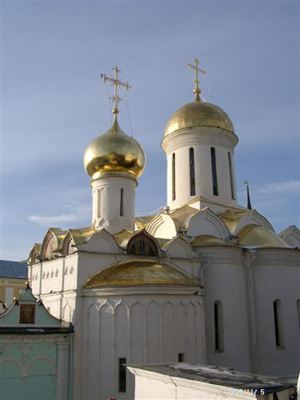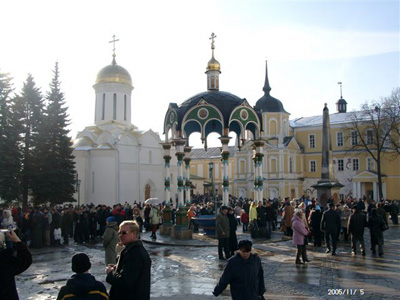 |
||||||||||
 |
||||||||||
|
1178: Trinity Cathedral, Sergiev Posad, Russia Mystery Worshipper: Merchant Trader. The church: Trinity Cathedral, Sergiev Posad, Russia. Denomination: Russian Orthodox. The building: Trinity Cathedral is situated in the lavra (monastery complex) known as Holy Trinity-St Sergius, founded in the 14th century by St Sergius of Radonezh. It is one of 13 churches in the lavra, and is a white compact building graced with golden domes rebuilt by St Nikon between 1408 and 1425. It is the most important but not the largest church on the site and is smaller than the nearby Dormition Cathedral built by Ivan IV in the 16th century. The church: The lavra is a living community. It includes the Metropolitan's chambers, which constitute one of the out-of-town residences of the Patriarch of Moscow and all Russia. The lavra is constructed as a kremlin (fortress) with impressive and beautiful 16th-17th century white walls with three tiers and six tiered towers. It is home to the relics of St Sergius, St Nikon, St Micah, St Serapion of Novgorod, Metropolitan Joasaph of Moscovy, Archimandrite Dionisius, and St Maxim the Greek. Trinity Cathedral contains a miraculous icon of the Holy Trinity designed and painted by the Russian artist Andrei Rublev and donated by Boris Godunov in 1600. The neighbourhood: The city of Sergiev Posad, situated some 50 km outside of Moscow, grew up around the lavra. It was known as Zagorsk in the Soviet era. The city is famous for its beautiful gardens and a Russian toy museum. The cast: A priest whose name was not given. The date & time: Saturday, 5 November 2005, 1.30pm. What was the name of the service? Molebens (prayer service) before the relics of St Sergius. How full was the building? The queue to approach the tomb of St Sergius stretched from halfway across the outside courtyard (say 150 people), through the atrium (another 40), and along the interior left wall of the cathedral, across the iconostasis to the tomb on the right side of the cathedral (another 50 people). In addition, there were another 40 people in the atrium and another 50 in the body of the cathedral, leaving just enough room to stand and move around. As people left, equal numbers replaced them. Did anyone welcome you personally? A very helpful Orthodox priest in the courtyard outside explained that the long queue was for those who wanted to approach the tomb of St Sergius, but that we were welcome to squeeze past through the door to go into the main part of the cathedral. Was your pew comfortable? Pew? Like most Orthodox churches in Russia, you stand or fall to the ground – see below. How would you describe the pre-service atmosphere? Given that this was an extended prayer service, I was only present for a part of the time. However, the people in the queue outside were talking quietly as they waited; it was clear that they were pilgrims rather than tourists. In the atrium, some people in the queue were writing down their prayer requests and others were buying candles and cards, while still others were saying their personal prayers and lighting candles under the icons. In the cathedral proper, both the queue and the others were listening to the payers chanted by the priest and joining in by crossing themselves at the correct times. All told, it was a very reverent atmosphere. What were the exact opening words of the service? I do not know, and would not have understood them if I had been there at the beginning. The priest chanted the entire service, which I believe was a mixture of scriptural excerpts, prayers from the liturgy, and the prayer requests being given him. What books did the congregation use during the service? None except for the prayer request papers. What musical instruments were played? None. The priest's chanting was unaccompanied by musical instruments. He was supported antiphonally by a woman in what appeared to be one of a handful of choir stalls at the back. Did anything distract you? I was standing listenng to the priest chanting when the woman from behind started her chant, making me jump. Later, a women dropped to the ground, prostrating herself. As my turn came to offer up my own prayers, I singed my sleeve as I tried to reach across the lighted candles to place my own candle in one of the few remaining slots. Was the worship stiff-upper-lip, happy clappy, or what? Traditional, unchanged for six centuries. As their turn came, people waiting in the queue kissed the relics, said their personal prayers, and in some cases passed their prayer request papers to the priest. Alternatively, people who were not in the queue made a smaller queue on the right side of the cathedral to pass their prayer requests.  Exactly how long was the sermon? No sermon. The architecture, liturgy and icons all preached their own message. Which part of the service was like being in heaven? The chanting, the prayerful atmosphere, the pure beauty of the place. And which part was like being in... er... the other place? Having to push through the crowd in the atrium to get out to find my friends. Knowing little Russian, I would never have been able to enquire of them had I lost track of them. What happened when you hung around after the service looking lost? It was not the sort of place, service or occasion where individuals would be acknowledged in a crowd. How would you describe the after-service coffee? Coffee was not offered. However, there was a queue of pilgrims carrying bottles to the spring in the Chapel-Over-the-Well to collect holy water. Before arriving at the lavra, my friends and I found temporal refreshment in Sergiev Posad in the form of a cup of coffee boiled in a pan. It was weaker than Turkish or Greek coffee, which you can at least discern from tea. In Sergiev Posad we found no place that was serving lunch, but on the way back to Moscow we stumbled upon a fantastic gourmet meal for next to nothing. How would you feel about making this church your regular (where 10 = ecstatic, 0 = terminal)? 6 – I found myself empathizing with the pilgrims who were visiting their holy places, and would go back to Sergiev Posad for another visit. However, this is not my tradition, and even if it were, I would want to go regularly to a less crowded place. Did the service make you feel glad to be a Christian? Yes. I was humbled by the prayerfulness and devotion of the pilgrims. I was part worshipper (not knowing Russian, the most I could manage was lighting candles and saying private prayers before the icons) and part tourist, and almost felt that I was trespassing on their holy ground. What one thing will you remember about all this in seven days' time? The chanting, the lady prostrating herself, the crowds, and the devotion of the pilgrims. |
|
|
||||||||||||||||||||||||||||||||||||
| More Mystery Worshipper reports | |||||||||||||||||||||||||||||||||||||||
 |
|||||||||||||||||||||||||||||||||||||||






